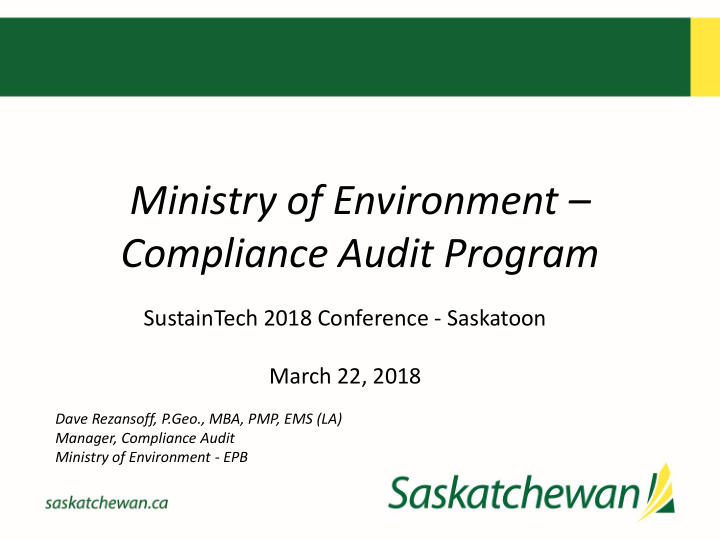



Ministry of Environment – Compliance Audit Program SustainTech 2018 Conference - Saskatoon March 22, 2018 Dave Rezansoff, P.Geo., MBA, PMP, EMS (LA) Manager, Compliance Audit Ministry of Environment - EPB
Safety Share • Safety at home: – Shoveling snow – proper lifting – Sharp objects – on counters, in dishwasher – Slippery surfaces / ice / sand buildup – Improper footwear / slippery soles – Poor lighting – Stuff left on stairs – Heavy backpacks slung on one shoulder • My challenge to you: – when you get home, do a home safety check AND commit to fix what you find !
Agenda • Background • Process • Results • Q and A
Background
History • Ministry Compliance Plan developed in conjunction with the RBR model – Modernized legislation – Environmental Code – Compliance audit model – Organizational changes – Advancement of information and management technology
Compliance Assurance • If we are allowing more interaction with the environment with less formal scrutiny, how do we ensure compliance? – Compliance education – Monitoring and surveillance – Auditing – Inspections
Compliance Framework • Improved level of compliance • Risk modeling Compliance • Public trust • Risk-informed approach Planning • Level playing field • Ministry and branch annual • Transparency compliance plans • Information resources • Established performance measures Compliance Outcomes Compliance • Compliance Compliance • Investigations & education • Administrative penalties Assurance Enforcement Tools • Monitoring and • Orders surveillance • Restorative justice • Auditing • Prosecution • Inspections • Civil action
Why Conduct Compliance Audits ? • The ministry’s compliance audit program addresses Section 78 of The Environmental Management and Protection Act, 2010 , the Act which replaced EMPA, 2002 on June 1, 2015.
What is a Compliance Audit ? • An audit is a systematic, independent and documented process for obtaining evidence and evaluating it objectively to determine the extent to which selected criteria are fulfilled. • A ministry compliance audit focuses on environmental regulatory compliance. • ENV uses compliance audits as one of its regulatory tools to assess the extent to which an Auditee is complying with its legal requirements.
Program Mandate • ...to provide independent, objective assurance services to the public of Saskatchewan, ensuring compliance with environmental laws and regulations within the regulated community to protect our environment.
Scope • ENV Compliance Audit can be conducted on anyone who: ▪ has been issued a permit, approval or authorization pursuant to any Act or regulation administered by ENV; ▪ Engages in an activity governed by an environmental protection plan (EPP); or ▪ Is required to comply with the Saskatchewan Environmental Code as enabled by any Act administered by the ENV. • Limitations: ▪ Federal Lands ▪ Other provinces
EPB Compliance Audit Section Executive Director Ash Olesen Director Mining, Industry, Audit Gerry Wudrich Mgr. compliance audit Dave Rezansoff Senior Compliance Senior Compliance Senior Compliance ~ 20 Pool Auditors Auditor Auditor Auditor Rob Bewer Hillary Prodahl ENV, HI, WSA Shelby Enevoldsen
Compliance Audit Section Services • Compliance auditing • Training • Performance monitoring and reporting • Communication • Compliance assessment
Process
Audit Process Preparation Define Obtain Prepare Prepare Scope and Background Audit Audit Plan Objectives Information Protocol Audit Opening Execution Meeting Document Inspections & Records Interviews Review Performance Prepare Prepare Evaluation & Closing Corrective Preliminary Audit Meeting Action Plan Communication Findings Report
Collecting Information to Reach Audit Conclusions Sources of information Inspection(s) Collected by appropriate Records and Docs Audit evidence sampling and verifying Interviews (documented in working Evaluating against audit papers ) Audit findings criteria (documented in findings sheets ) Reviewing Audit Conclusions
Typical Finding Protocol Criteria Finding Finding # Finding Condition Expected Reference Reference Type MW-01 ABC-2017- There are two 5000 L Storage tanks that HSWDGR, 9(1) I aboveground storage contain hazardous 01 tanks (#s 6001, 6002) substances with a that contain gasoline capacity of over on site, that are not 4000 L shall be registered with the registered with the ministry. ministry.
Results
Audit Types, Topics and Locations Field Audits Desk Audits - Mine sites (oil, potash, coal, uranium, ‐ Hydrostatic testing zinc, copper, gold, silver) ‐ Sensitive species detection - Pulp and paper mills ‐ Hydrostatic testing - Canola crushing facilities ‐ Qualified persons - Steel manufacturing submissions - Salt manufacturing ‐ Corrective Action Plan (CAP) - Farm equipment manufacturing accepted solutions - Forestry operations submissions - Landfills, transfer stations and ‐ Impacted sites submissions regional waste management ‐ Discharge and discovery authorities reporting - Industrial landfills ‐ Contaminated soil disposal at - Ethanol facilities approved locations - Heavy oil upgraders ‐ Stack emissions testing - Fish farms - Water and wastewater treatment facilities - Aggregate sites - HSWDG facilities - Oil recycling programs - Water / sewage main construction - Chemical manufacturing facilities
…by the numbers…
Common Finding Themes – Permittee awareness of permit / approval conditions, legislation including Code requirements – HSWDG facility construction / storage / alteration / closure – Appropriate selection of accepted / alternative solutions – Waste water pond level management – Tailings slope stability monitoring and management – Discharge and discovery reporting – Halocarbon control – Emergency preparedness and response plans
… it looked OK from the other side… • Secondary containment filled with drums and pallets (for many weeks) – Unapproved for this method of storage – Free storage capacity unavailable in the event of tank overflow / failure
Program Measures and Trends • Key program performance measures: – % of audits completed vs. approved plan – % of corrective actions closed from 2 years ago, and 1 year ago • Compliance Audit is continuing to improve performance: – Focused audit scopes and objectives – Diving deeper vs. being “a mile wide and an inch deep” – Continuing to audit fewer protocol items resulting in higher noncompliance rates
Q and A
Contact Information Dave Rezansoff, MBA, P.Geo., PMP, EMS(LA) Manager, Compliance Audit Phone: 306-933-6449 Email: dave.rezansoff@gov.sk.ca
Recommend
More recommend